AMD's Phenom II X4 965 Black Edition
by Anand Lal Shimpi on August 13, 2009 12:00 AM EST- Posted in
- CPUs
And so it ends at 4GHz, again.
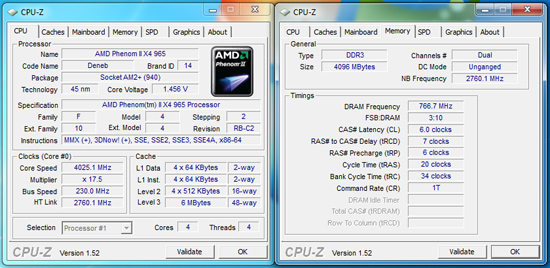
A 625MHz overclock is nothing to sneeze at, but it certainly does not come near those 6GHz~7GHz clock speeds we see on a regular basis with the Phenom II series. Granted, reaching those high clock speeds requires LN2 cooling but there is another important reason. We have discussed it several times and still do not have an acceptable answer from AMD about the inability of the Phenom II to clock much past 4GHz with a 64-bit operating system. Even with LN2 cooling we have not successfully benched past 4.4GHz with a 64-bit OS.
Once again, we tried XP 64-bit, Vista 64-bit, and Windows 7 64-bit and the results are always the same. As we near 4GHz, the voltage requirements increase dramatically and the clocking ability of the processor decreases in much the same manner. This does not occur in a 32-bit operating system, which happens to be the recommendation for any sort of benchmarking activities with the Phenom II.
That said, running this particular processor in the 3.8GHz~4GHz range offers performance that should satisfy just about any desktop user. Moreover, it is easy to do, in fact, much easier than our collection of 955BE samples scattered about the labs.
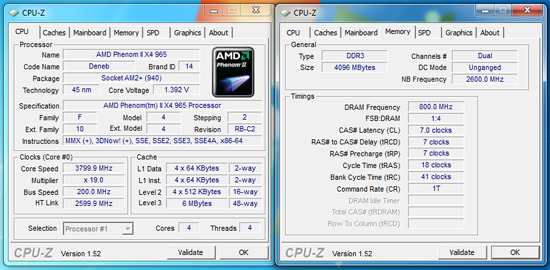
The stock Core VDDC (VCore) is 1.4V as delivered from AMD. At this stock voltage and a slight bump in NB Core voltage to 1.250V, we hit 3.8GHz with a 2.6GHz Northbridge speed on our MSI 790FX-GD70 motherboard. The AMD specific 4GB DDR3-1600 kit from OCZ was set at 1.65V with 7-7-7-18 1T timings. We used the retail air cooler and load temperatures stayed around 58C~62C with Windows 7 Ultimate x64 as the operating system of choice.
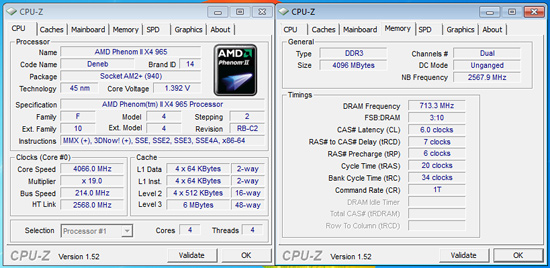
At the same voltages but utilizing Windows 7 Ultimate x86 we end at a final core speed of 4.066GHz (19x214). Northbridge speed is set to 2.567GHz and memory at DDR3-1426 with 6-7-6-20 timings. This is a similar pattern when testing the Phenom II cpus on air-cooling; we typically can clock the processor about 200MHz higher at similar voltages and settings when using a 32-bit OS in place of a 64-bit OS. Our particular sample made it to 4.2GHz on 1.50V with a NB speed of 2.4GHz using our Vigor Monsoon III LT air cooler. We almost hit 4.3GHz at 1.52V with a 2.7GHz NB speed on water cooling before temperatures spiraled out of control.
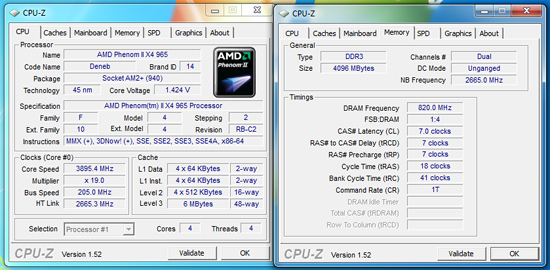
We swapped out our retail air cooler for the Corsair Hydro H50 to hit our top two overclocks. We reached 3.89GHz on 1.45V with the NB speed of 2.66GHz and memory running at DDR3-1640 on 7-7-7-18 timings. When running higher NB speeds, it is a requirement to keep the core as cool as possible to guarantee stability under load conditions. This was our preferred setting as temperatures stayed below 54C under load and the system was very responsive in a variety of applications, especially gaming.
Our best core clock reached 4.025GHz on 1.475V (shown at the top of the page) with a 2.76GHz NB speed and memory operating at DDR3-1532 on 6-7-6-20 timings. Temperatures crept back up to the 58C range under full load conditions.
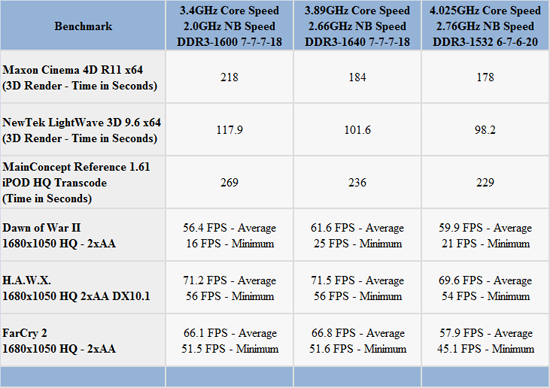
The 4.025GHz setting offered the best results in several video/audio transcoding benchmarks due to pure processor speed, it was actually slower in gaming than the 3.89GHz setting thanks to improved memory bandwidth and internal latencies.
















54 Comments
View All Comments
Griswold - Saturday, August 15, 2009 - link
Thats not the point, dummy, its the maximum heat disssipation and that people mistake it for the power it draws from the wall plug. Got it?Eeqmcsq - Thursday, August 13, 2009 - link
"The 800 series Phenom II X4 is gone, as are the DDR2-only Phenom II X4 940 and 920. Most of the 700 series is also done with."I can understand AMD ending the 800 series and the AM2+ only Phenom IIs. But is this statement saying that AMD won't upgrade their X3 720 to a faster triple core, despite better yields? Many people have said that the 720 is AMD's best bang-for-the-buck value. I'd think that AMD would update this segment also.
Ryun - Thursday, August 13, 2009 - link
My guess is AMD is working on positioning their lineup to fight against Lynnfield in the lower end. The triple cores are awesome, no doubt but look at what we've got now:1.) Phenom II 945 with a TDP of 95W, Phenom II 720 with a TDP of 95W. I'm willing to bet that AMD is planning to move an AMD 925 down to around the same price as the 720. OEMs will love the lower heat requirements and the lowered price. These are going to combat probably against the Core i5's without hyperthreading and from what I've seen I'd wager they'd do pretty well.
2.) Last I checked there were still plans to make triple and quad cores of the athlon ii design. These are gonna go in the low end to combat against clarkdale I'd suppose. OEMs selling PCs are probably wanna going to get rid of their stockpile of DDR2 memory somehow so I'd surmise these would sell very well also.
All and all I'd wager that AMD will do fine until Bulldozer releases as long as they a) Make sure they market these processors well to OEMs b) really ramp up their mobile lineup in the coming months
Look at the 4800 series success afterall. Most people just don't care about the highend and if AMD can have competitive prices they should do well.
Nalyk - Thursday, August 13, 2009 - link
Is this just a straight clock bump on AMD's part from the 955 due to improved manufacturing? And if so why would consumers shell out another $50 if the head room is already there on the 955 I figure half the reason people buy the Black Editions is so they can play with the multiplier. Am I wrong?I suppose I can understand their need for cash, but I personally feel it difficult to justify shelling out another $50 for 200Mhz especially if the head room is there already on the same chip. Or by releasing this chip are they implying that there's even more head room on this 965?
Eeqmcsq - Thursday, August 13, 2009 - link
Page 6, char for "POV-Ray 3.73 beta 23 Ray Tracing Performance".Vozer - Thursday, August 13, 2009 - link
Based on our preliminary results, I'd expect the race to be reasonably close between the 965 BE and the Core i5 750 but the i7 850 may prove to be the sweet spot at only $40 more.Core i7 850? :)
jmke - Thursday, August 13, 2009 - link
Yup, Core i7; All Nehalem CPUs with 8 threads are i7 series, those with 4 threads are i5 series; those without turboboost are i3http://www.madshrimps.be/vbulletin/f22/intel-core-...">http://www.madshrimps.be/vbulletin/f22/...870-850-...
http://en.expreview.com/2009/08/11/a-simple-way-to...">http://en.expreview.com/2009/08/11/a-si...tinguish...
Eeqmcsq - Thursday, August 13, 2009 - link
Er, sorry, page 5ToeringsNthong - Saturday, January 22, 2011 - link
One main problem i see with this review although its a good review is you should also include the SAME CLOCK SPEEDS! like example i'll just pick a RANDOM cpu like the q6600 you are comparing something at 2.4 ghz to something that's running at 3.4ghz that just don't make any sense whatsoever ! can you please explain how is that is a fair comparison?And dont try and say we don't over clock these! anyone with half a brain knows the q6600 can hit 3.4ghz without even breaking a sweat ! even with a crappy mobo ! I know this isn't a overclock review BUT STILL you should have included a fair comparison like hardocp does they always do a APPLES TO APPLES comparison.
Second thing is you mention you don't know why intel still sells socket 775 cpus,i know why its because we are not all rich like you guys and cant afford a complete upgrade,
Some of us still have 775 motherboards and don't have the money to run out and buy new motherboards and ddr3 ram,does that explain it to you?? Glad i could be of assistance.